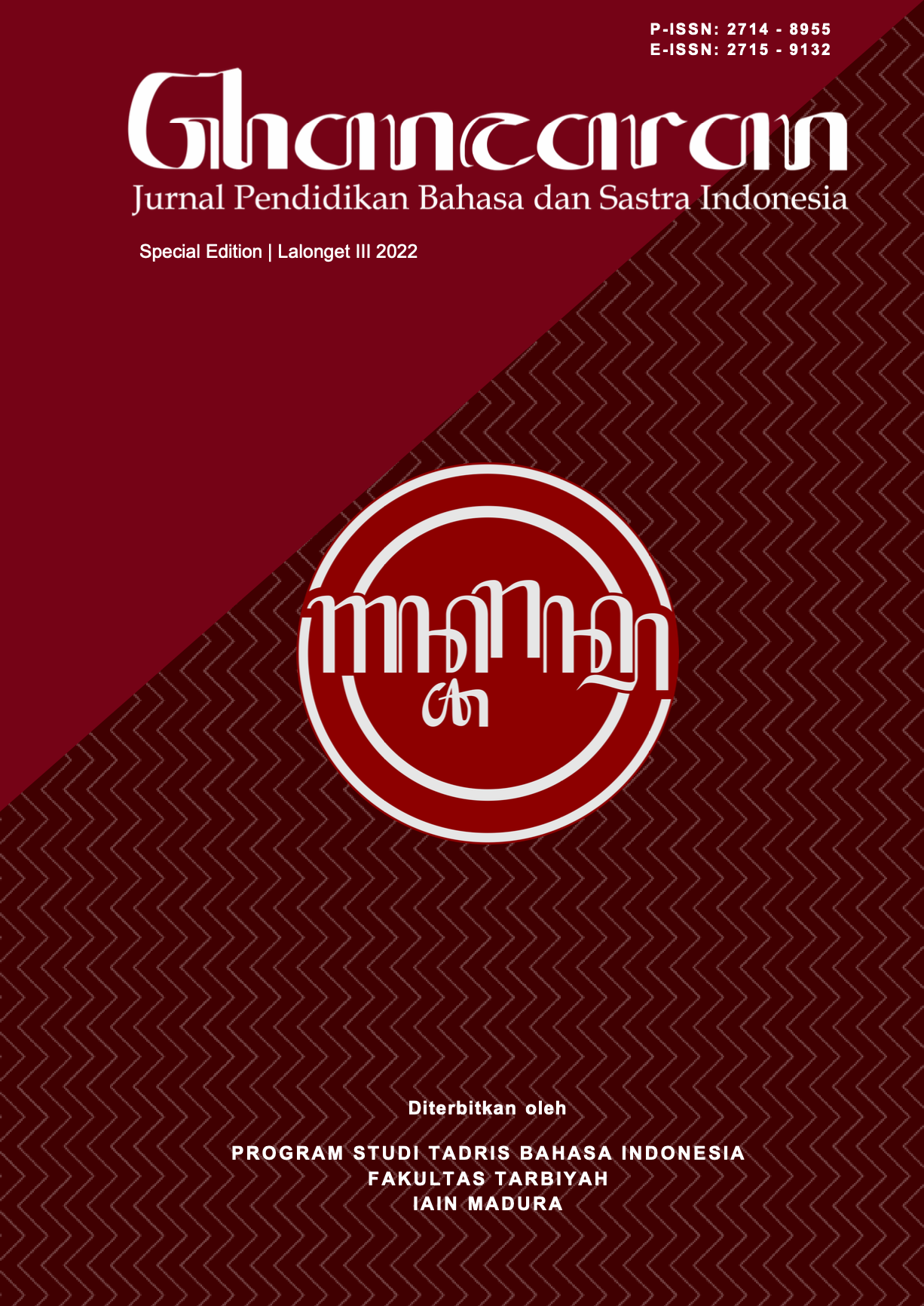Perubahan Perilaku Siswa dalam Pembelajaran Tatap Muka di Kelas Pascapandemi : Potret Pembelajaran di Awal Era Merdeka Belajar
 Abstract views: 515
,
Abstract views: 515
,
 PDF downloads: 521
PDF downloads: 521
Abstract
About all educational levels have started offering offline sessions lately, nearly two years after beginning home-study or hybrid classes. When students return to in-person learning at school, there are signs of behavioral changes. This study set out to describe how student behavior changed in terms of knowledge, attitudes, and skills during face-to-face instruction during the post-pandemic. This study employed a quantitative methodology to address this question by distributing questionnaires to students in elementary, middle, and high schools in the cities of Pamekasan and Mojokerto. For the goal of triangulation, interviews with teachers were also performed in 11 provinces in western Indonesia. s a result, there were both positive and negative behavioral changes among elementary, middle, and high school students. To improve learning, teachers, parents, and students themselves must be able to recognize changes in post-pandemic student behavior. Though it can certainly facilitate human endeavors, teachers' roles as educators have not yet been fully replaced by technology, at least not yet.
Downloads
References
Cahyani, A., Diah Listiana, I., Puteri, S., & Larasati, D. (2020). Motivasi Belajar Siswa SMA pada Pembelajaran Daring di Masa Pandemi Covid-19. IQ (Ilmu Al-Qur’an): Jurnal Pendidikan Islam, 3(01), 123–140. https://doi.org/10.37542/IQ.V3I01.57
Heider, K. L. (2021). Isolation, Burnout, and a Lost Sense of Belonging: Combating the Challenges of Distance Education during a Pandemic. Distance Learning, 18(1), 25–35.
Illarionova, L. P., Karzhanova, N. V., Ishmuradova, A. M., Nazarenko, S. V., Korzhuev, A. V., & Ryazanova, E. L. (2021). Student Attitude to Distance Education: Pros and Cons. Cypriot Journal of Educational Sciences, 16(3), 1319–1327. https://doi.org/10.18844/cjes.v16i3.5857
Kasali, R. (2022). Celaka, Anak Kita Berubah Pasca Kembali ke Sekolah - YouTube. Youtube. https://www.youtube.com/watch?v=HDxH30N7giU&t=398s
Khurriyati, Y., Setiawan, F., & Binti Mirnawati, L. (2021). DAMPAK PEMBELAJARAN DARING TERHADAP HASIL BELAJAR SISWA MI MUHAMMADIYAH 5 SURABAYA. Jurnal Ilmiah Pendidikan Dasar, 8(1), 91–104. https://doi.org/10.30659/PENDAS.8.1.91-104
Lumina. (2020). Higher Ed Budgets for the Post-COVID Era: Now’s Our Chance to Do This Right. Bill & Melinda Gates Foundation.
Nugroho, T. S. A., & Kusumaningrum, M. R. M. (2021). Strategi Pembelajaran Daring Praktik Vokal di Prodi Musik Fakultas Seni Pertunjukan ISI Yogyakarta. Tamumatra: Jurnal Seni Pertunjukan, 4(1). https://doi.org/10.29408/TMMT.V4I1.4018
Putikadyanto, A. P. A., Efendi, A. N., Romadhon, S., Amin, M. B., & Sefrianah, N. A. (2021). Persepsi Siswa terhadap Pembelajaran Bahasa Indonesia Berbasis Daring di SMAN 1 Pasuruan. GHANCARAN: Jurnal Pendidikan Bahasa Dan Sastra Indonesia, 104–116. https://doi.org/10.19105/GHANCARAN.VI.5398
Putikadyanto, A. P. A., Zamahsari, G. K., & Violando, W. A. (2021). Investigating Positive Perceptions of High School Students’ Distance Learning Experiences During a Pandemic. Abjadia, 6(2), 170–181. https://doi.org/10.18860/ABJ.V6I2.13874
Rizvi, Y. S., & Nabi, A. (2021). Transformation of learning from real to virtual: an exploratory-descriptive analysis of issues and challenges. Journal of Research in Innovative Teaching & Learning, 14(1), 5–17. https://doi.org/10.1108/JRIT-10-2020-0052
Salman, A. M., & Shahadab, F. H. (2022). Obstacles of Teaching Distance Universities Courses in Light of E-Learning Quality Standards. Cypriot Journal of Educational Sciences, 17(4), 1244–1257. https://doi.org/10.18844/cjes.v17i4.7145
Santos, R. A. (2021). Distance Learning in Modern Times: Challenges for Contemporary Solutions. American Association for Adult and Continuing Education.
Shafiyeva, U. (2021). Assessing Students’ Minds: Developing Critical Thinking or Fitting into Procrustean Bed. European Journal of Education (EJE), 4(2), 79–92.
Svobodova, Z., Kursch, M., & Veteska, J. (2021). Problems and Obstacles of Distance Learning in the Point of View of Primary School Teachers in the “COVID Period”. International Association for Development of the Information Society.
Uruk, F. H. (2021). MENGUAK KONDISI MOTIVASI BELAJAR SISWA DALAM PEMBELAJARAN DARING PADA MASA PANDEMI COVID-19. Jurnal Inovasi Penelitian, 1(10), 2227–2234. https://doi.org/10.47492/JIP.V1I10.451
Xie, C., Li, C., Sung, S., & Jiang, R. (2022). Engaging Students in Distance Learning of Science with Remote Labs 2.0. IEEE Transactions on Learning Technologies, 15(1), 15–31. https://doi.org/10.1109/TLT.2022.3153005
Copyright (c) 2022 GHANCARAN: Jurnal Pendidikan Bahasa dan Sastra Indonesia

This work is licensed under a Creative Commons Attribution-ShareAlike 4.0 International License.
Ghancaran: Jurnal Pendidikan Bahasa dan Sastra Indonesia uses an Open Access Policy under the Creative Commons Attribution-ShareAlike 4.0 International License. Authors publishing in this journal agree to the following terms:
- Ghancaran Journal holds the copyright and grants the journal rights for first publication with the work simultaneously licensed under a

The work is distributed under Creative Commons Attribution-ShareAlike 4.0 International License which allows others to share, copy, and redistribute the material in any media or format and adapt, remix, change, and develop the material even for commercial purposes, as long as it is stated credit and license derivative works under similar terms. - Authors may make additional contractual arrangements for non-exclusive distribution of the journal's published work version.
- Authors are permitted to post their work online (e.g., in institutional repositories or on their websites) before and during submission, as doing so may lead to productive exchange.


















